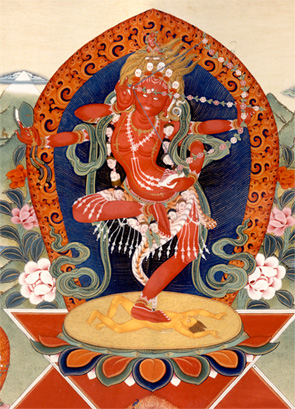Kurukulla: Difference between revisions
Jump to navigation
Jump to search
Mike Engle (talk | contribs) |
Mike Engle (talk | contribs) |
||
| Line 6: | Line 6: | ||
==External Links== | ==External Links== | ||
*[http://www.himalayanart.org/pages/kurukulla/index.html Outline page on Himalayan Art] | *[http://www.himalayanart.org/pages/kurukulla/index.html Outline page on Himalayan Art] | ||
* | *{{84000|read.84000.co/translation/UT22084-081-006.html|The Practice Manual of Noble Tārā Kurukullā}} | ||
*[http://all-otr.org/vajrayana/38-magnetizing-activity-what-is-it-how-to-practise-it Orgyen Tobgyal Rinpoche on Kurukulla and Magnetizing Practice] | *[http://all-otr.org/vajrayana/38-magnetizing-activity-what-is-it-how-to-practise-it Orgyen Tobgyal Rinpoche on Kurukulla and Magnetizing Practice] | ||
[[Category:Buddhas and Deities]][[Category:84000 Translations]] | [[Category:Buddhas and Deities]][[Category:84000 Translations]] | ||
Revision as of 16:00, 15 January 2018

Kurukulla (Skt. kurukullā; Tib. རིག་བྱེད་མ་, rikjéma; Wyl. rig byed ma) — a female deity of the Lotus family, associated with the activity of magnetization or enchantment. She is usually depicted as red in colour, in dancing posture and holding a flowery bow and arrow. She is also one of the Twenty-One Taras mentioned in the ancient Tara tantras.
It should be noted that in her well known mantra, it says Kurukulle and not Kurukulla, yet this is because of the vocative form of Sanskrit grammar. The proper noun in Sanskrit is thus Kurukulla, although Tibetans call her Kurukulle.
External Links
- Outline page on Himalayan Art
 [read.84000.co/translation/UT22084-081-006.html The Practice Manual of Noble Tārā Kurukullā]
[read.84000.co/translation/UT22084-081-006.html The Practice Manual of Noble Tārā Kurukullā]- Orgyen Tobgyal Rinpoche on Kurukulla and Magnetizing Practice